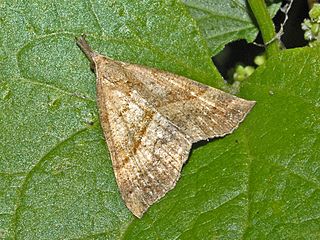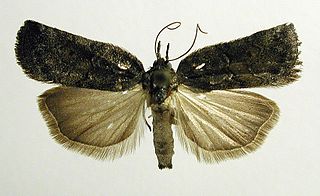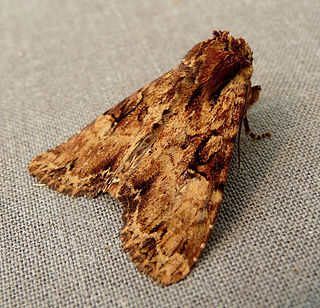
Hypena proboscidalis, the snout, is a moth of the family Erebidae. The species was first described by Carl Linnaeus in his 1758 10th edition of Systema Naturae.

Hoplodrina blanda is a moth of the family Noctuidae. It is found in the Palearctic realm.

Nycteola revayana, the oak nycteoline, is a moth of the family Nolidae. The species was first described by Giovanni Antonio Scopoli in 1772. It is found from Europe and east across the Palearctic to Japan and India.

Apamea epomidion, the clouded brindle, is a moth of the family Noctuidae, sub-family Hadeninae. The species was first described by Adrian Hardy Haworth in 1809. It is found throughout continental Europe, the British Isles, Sweden and Central Asia. It is also found in the Altai Mountains, west Siberia, and in Amur.

Dactylethrella bryophilella is a moth in the family Gelechiidae. It was described by Walsingham in 1891. It is found in the Democratic Republic of Congo (Equateur) and Gambia.
Cathegesis angulifera is a moth in the family Gelechiidae. It was described by Walsingham in 1897. It is found on the West Indies.
Dichomeris delotella is a moth in the family Gelechiidae. It was described by August Busck in 1909. It is found in Mexico (Sonora) and the southern United States, where it has been recorded from Arizona and California.
Arogalea archaea is a moth of the family Gelechiidae. It is found in Mexico (Guerrero).
Athrips ptychophora is a moth of the family Gelechiidae. It is found in South Africa, where it has been recorded from Eastern Cape, Western Cape and Mpumalanga.
Compsolechia glaphyra is a moth of the family Gelechiidae. It was described by Walsingham in 1910. It is found in Mexico.
Anacampsis cornifer is a moth of the family Gelechiidae. It was described by Thomas de Grey, in 1897. It is found in the West Indies.
Anacampsis insularis is a moth of the family Gelechiidae. It was described by Thomas de Grey in 1897. It is found in the West Indies.
Anacampsis lapidella is a moth of the family Gelechiidae. It was described by Thomas de Grey in 1897. It is found in the West Indies (Grenada).
Antaeotricha acrograpta is a species of moth of the family Depressariidae. It is found in French Guiana, Guyana and Brazil.
Stenoma nebrita is a moth of the family Depressariidae. It is found in Panama, Costa Rica and Guyana.
Antaeotricha orthotona is a moth of the family Depressariidae. It is found in French Guiana.
Antaeotricha admixta is a moth in the family Depressariidae. It was described by Lord Walsingham in 1913. It is found in Mexico (Guerrero).
Energia subversa is a moth in the family Depressariidae. It was described by Walsingham in 1912. It is found in Mexico.
Gonioterma aesiocopia is a moth in the family Depressariidae. It was described by Lord Walsingham in 1913. It is found in Mexico and Panama.
Moca aphrodora is a species of moth in the family Immidae first described by Edward Meyrick in 1922. It is found in Brazil and Peru.




